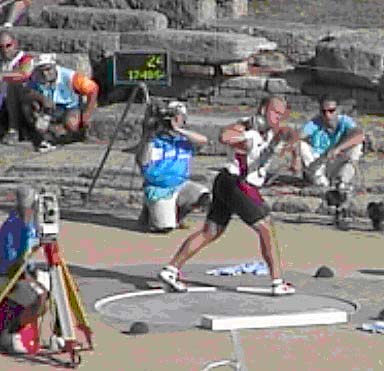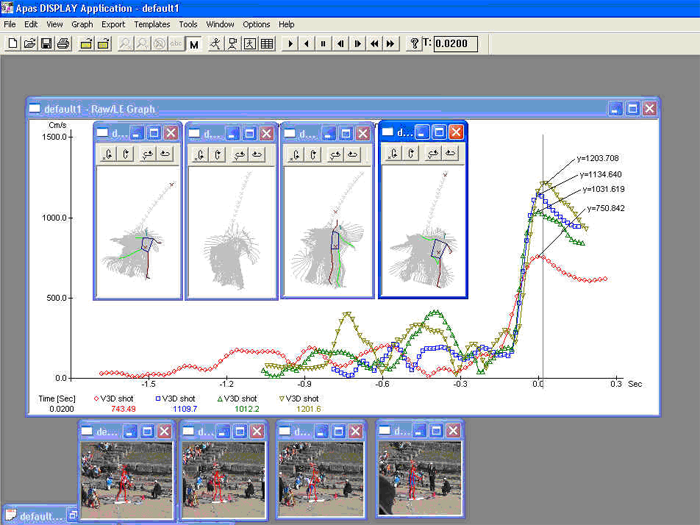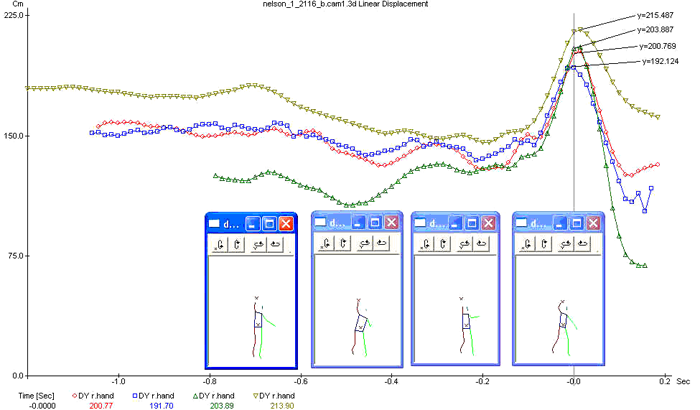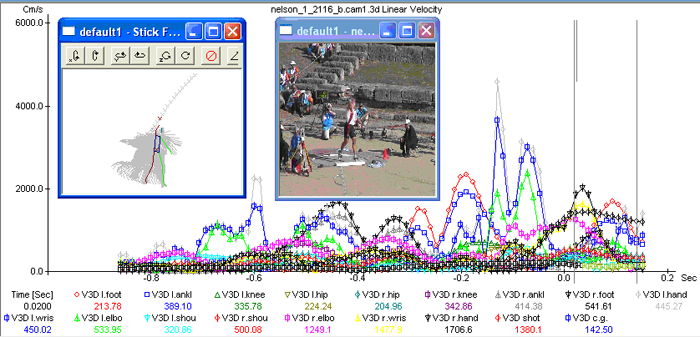Shotput
Biomechanical Analysis of the Shot-Put Event at the 2004 Athens Olympic Games
Gideon Ariel, Ph.D.1, Ann Penny1, John Probe1, Rudolf Buijs1, Erik Simonsen3,
Alfred Finch2, and Larry Judge4
1 Institute for Biomechanical Research, Coto Research Center, Coto De Caza California,
2
Indiana State University, Terre Haute, Indiana, USA,
3 Institute of Medical Anatomy
University of Copenhagen, Denmark,
4 University of Florida, Gainesville, Florida
The purpose of this study was to analyze the best shot put performances in the
Athens 2004 Olympic Games. Multiple high speed digital video cameras were placed
in specific locations on the field at proper angles in order to capture the performance
of the athletes in the preliminaries and finals. Two stationary cameras were placed
at 45 degrees to each other. In addition 3 more cameras used by the NBC broadcasting
were used to assist the other 2 cameras. Temporal and kinematics variables were
calculated from the videos records and were analyzed yielding three-dimensional
biomechanical results. Patterns of the segmental movements were used rather then
absolute values, to assist the athletes and the coaches in the analysis of the performances.
Kinematics parameters for the best 3 final performers were presented in this study.
Keywords: shot-put analysis, kinematic analysis; angular velocities; linear
velocities; angle of release; 2004 Olympic Games.
Introduction
The shot put competition at the 2004 Athens Olympiad was held in
the Ancient Olympia stadium. This was the site of the ancient Games of the Olympiad,
2,800 years ago. Despite skepticism from the rest of the world, the organizers of
the Athens games did so many things right and nothing exemplified this more than
holding the shot put competition at Olympia. In a games already steeped in history,
the organizers thoughtfully connected the ancient and modern Olympics in a serene
setting that was so unusual that it will probably be remembered as one of the highlights
of these games whenever they are recalled. The biomechanical analysis of the Shot
Put event was sponsored by the International Track and Field Coaches Association.
This was the only biomechanical analysis performed at the Athens Olympic Games where
cameras were placed on the performance field. The competition was exciting and the
setting was as intimate as it was historical. The shot put normally takes place
in the middle of the field with the track separating the crowd from the event that
seems so distant as if it's happening in another place. In Olympia, the shot put
took center stage as the only event being competed with 15,000+ fans watching right
on top of it from the grassy knoll right next to the pit. It was great to be a part
of it. The crowd was treated to a fascinating men's event, which ended in controversy
when the Ukraine's Yuriy Bilonog tied the United States' Adam Nelson, which meant
Bilonog would really beat Nelson, unless Nelson could come back with one last amazing
throw, which he did, except he fouled, although he stated he did not foul, but video
images really showed that a foul ocurred during the crucial final attempt. So Nelson
had to settle for the silver, while two other Americans, John Godina and Reese Hoffa,
finished out of contention, far short of his prediction that Americans would sweep
the event.
The purpose of this project was to collect video records of competitors at the 2004
Olympic Games at Olympia, Greece where the shot put event was conducted. Multiple
cameras were placed in key angular locations to capture the activities during the
Olympic Games. The cameras were place on the field at specific distance and angle
relative to the shot put circle. In addition to the stationary cameras on the field,
cameras outputs from the television broadcasting companies were used in assisting
the stationary cameras.
All throws were recorded at 60 frames per second and performances were analyzed
for the present study. All the men and women throws at the preliminary and finals
were collected and analyzed. Due to publishing restrictions, only the best 3 performers
were analyzed for the present paper. The parameters measured were the body�s segmental
velocities, center of mass pathway, and release velocity. The kinematic patterns
of the various athletes� segmental positioning were presented for visual interpretation.
Methods
Multiple high speed digital cameras (60 fps) were used to collect videos
of the shot put performers in the 2004 Olympic Games. All throws at the preliminaries
and final performances were recorded. Videos collected were transferred automatically
to two notebook computers via IEEE1394 interface PCMCIA cards, and synchronized
to produce trimmed files representing the complete throws. The trimmed videos from
each performer were transmitted through the Internet to a server in order to distribute
the data to multiple locations for analysis. All the video digital cameras recorded
at 60 fields per second. Shown in Figure 1 are 2 of the 5 cameras views utilized
in digitizing the data.
Dimensions of known factors and various other measured objects in the field of view
were used for the calibration points. Since it was impossible to place a pre-measured
calibration frame in the field for security reasons, known measurements on the field
as well as utilizing the athletes� body dimensions were used. More measurements
were made on the field the next day.
One can see the measurement procedures in the
next day at:
www.macrosport.com/activities/Olympic-Games-2004

The results were verified against known official measurements of the shot put circle
area.
The Ariel Performance Analysis System (APAS) was used to conduct the biomechanical
processes. Synchronized data sequences from each of the cameras views were utilized.
For each camera view, 19 points were digitized. The body parts included the foot,
ankle, knee, hip, wrist, elbow and shoulder for the left and right sides of the
body as well as the right hand, shot put, and base of the neck, mastoid process
the top of the head. Data points were digitized and entered into the three dimensional
linear transformation (DLT) module and converted to real displacements. The real
coordinate endpoints were smoothed using cubic spline filter.

Figure 1 - Two camera views of shot putting performance

Figure 2 - Strobe images to represent the different styles
Results
The present kinematics analyses yielded an enormous volume of results.
However, because of the time and space considerations, the most significant parameters
for the shot put technique were selected for analysis and discussion.
The results of the top 3 top athletes were selected for this study. The remaining
data is published on a Website and will be presented in the oral presentation at
the conference.
The resultant velocities curves calculated for the best throws are presented in
Figure 3 and the release heights for the athletes are shown in Figure 4.

Figure 3 - Shot put velocities curves

Figure 4 - Vertical heights curves of the hand representing the release heights.
Shown in Figure 5 are the three dimensional resultant velocities for the feet,
knees, hips, shoulders, elbows, hands, and the shot put during the finals competition
by Belonog, Nelson, and Olsen.

Figure 5 - Velocity curves for body�s segments
Table 1 - Selected Kinematic Performance Parameters of the Top Three Throwers
| Athlete |
Result |
Distance
m |
Release height
m |
Shot velocity
m/s |
Release angle
Rad (deg) |
| Yuriy Belonog |
Gold (1) |
21.16 |
2.55 |
13.85 |
0.58 (33) |
| Adam Nelson |
Silver (2) |
21.16 |
2.33 |
13.95 |
0.58 (33) |
| Joachim Olsen |
Bronze (3) |
21.07 |
2.31 |
13.60 |
0.72 (41) |
Discussion
The shot put distance depends on a variety of factors. The angle
in which the athlete can achieve the optima acceleration of his/her arm segments
would represent an optimized performance. Factors that influence optimal performance
would be the release height, release velocity, and release angle. Segmental acceleration
depends on the technique that allow optimal combinations of the above parameters.
Nelson and Yuriy both obtained the same throwing displacement, but Nelson was able
to generate 7.2% faster shot projection velocity with 9.4% lower release height,
and both competitors putted at the same projection angle. From the present analysis
it was determined that Adam Nelson was closest to achieving optimal performance
for his movement parameters.
References
- McCoy, R. et al. (1984). Kinematic analysis of elite shot-putters. Track Technique,
90:2868-2871.
- Bashian A., Gavoor, N., and Clark, B. (1982). Some observations on the release in
the shotput. Track and Field Quarterly Review 82(1), 12.
- Ariel, G.B., (1980). Biomechanical analysis of shot putting. Track and Field Quarterly
Review, 79, 27-37.
- Ariel, G.B. (1973). Biomechanical analysis of the shot-put utilizing the center
of gravity displacement. Track and Field Quarterly Review, 73, 207-210.
- Ariel, G.B. (1973). Computerized biomechanical analysis of the world's best shot-putters.
Track and Field Quarterly Review, 73, 199-206.
See also